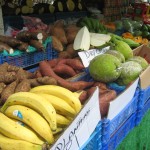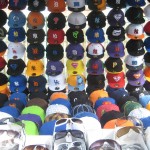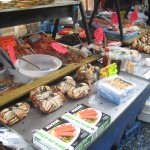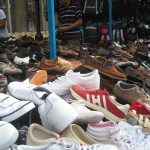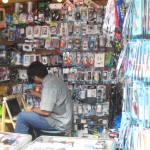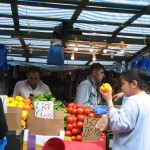[kml_flashembed movie="http://www.youtube.com/v/0_N3ivscSJg" width="425" height="350" wmode="transparent" /]Photo slideshow with narration: http://www.youtube.com/watch?v=0_N3ivscSJg
We travelled to the Market (located in the borough of Southwark) via the Tube’s northern line, which we exited at Kennington. From there, we proceeded to walk for about 10 minutes through residential neighborhoods until we arrived at the Market, the main entrance of which was announced by a large lettered gate.
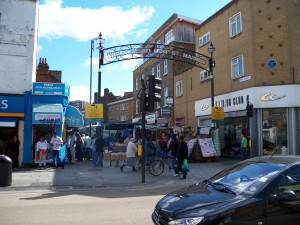
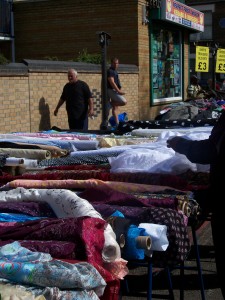
The Market, while not as large as many of the others London has to offer, was unique and vibrant. The majority of the goods were, somewhat unusually, clothing, shoes, accessories and textiles, as well as electronics, cosmetics, Cds & Dvds and other assorted items.
Many of the items were American-themed or American-style clothing or otherwise imported. The small amount of stalls with food were predominantly fruit and veg stands.
The vendors (and many of the customers- presumambly, the residents of the neighborhood) were typically either Jamaican/Afro-Caribbean, Middle Eastern or Eastern European, as well as a small number of Cockneys.
The vendors and customers engaged in an almost perpetual friendly sort of argument with each other: we overheard one conversation between an elderly Cockney vendor and his elderly female Cockney customer. After giving her his prices, he added “Tha’s cheap- betta than th’supermarket” and she replied snarkily “Tha’ ‘taint cheap- tha’s ‘spensive.” We didn’t experience much of the hassling that is typically found at marketplaces: we were pretty much left alone and didn’t hear
any creative vendor’s attempts to bring customers to their wares. However, on our way back were heard slightly more vocal advertisement and, on one memorable instance, a use of Cockney slang-insults to get attention: “1.50, hey, Lady wiff the mustache, over ‘ere!”
After we had covered the whole market (which stretched about 3 blocks) we explored the surrounding area which was mainly residential and consisted largely of low-income estate complexes (immediately recognizable through the tell-tale
sign of laundry lines across the balconies). Again, we mostly encountered people similar to the vendors of the market: largely immigrants or foreigners as well as lower class white Brits. While the neighborhood was relatively well maintained in terms of infrastructure, there were some physical signs of its standing as a lower class area: we found a telephone box with its windows smashed in and its inside completely covered in broken glass and cigarette stubs. In addition to this, many of the buildings were surrounded by barbed wire and a number of walls and fences were in a state of decrepitude. However, the area also contained some nice (but small) parks and at least two handsome churches. We were struck by several banners and posters put up by members of the community, protesting the borough council’s various planned developments to the area, some of which would encroach upon their parks. 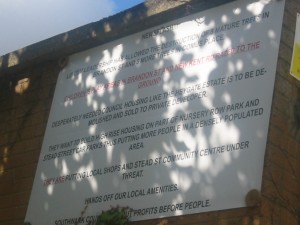
Speaking of religion . . . in the market, we found about 3 Christian bookstands, alongside many self-help books by American preachers. We also noticed a large Muslim population with many women wearing headscarves and other traditional garb. We detected a strong sense of community among the ethnic/religious groups: there were many hairdressers and stores catering exclusively to the Afro-Caribbean women as well as Jamaican DVD/Music stands for the men. There were multiple Halal butchers and restaurants as well as fishmongers.

All in all, the East Street Market and surrounding Southwark clearly exemplify a vibrant, diverse and community-oriented place.

